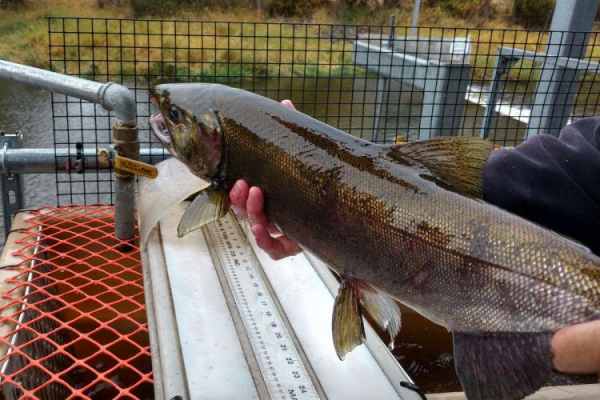 |
One of the first coho salmon to return to historic habitat on the Lostine River this year. Releases starting in 2017 reintroduced the fish to the northeast Oregon river after an absence of almost 50 years. Photo Credit: Nez Perce Tribe
Coho salmon are returning to northeast Oregon’s Lostine River in record numbers almost five decades after they disappeared from the same basin. Once again the coho are supporting tribal harvest and a new Oregon recreational fishery.
More than 5,000 adult coho have passed Bonneville Dam on their way to the Lostine this fall. This is the result of reintroductions by the Umatilla and Nez Perce tribes and the Oregon Department of Fish and Wildlife beginning in 2017. Biologists expect many of the fish to make it back to the Lostine River.
It is by far the largest return of coho salmon to the Grande Ronde River and its tributary, the Lostine, since their reintroduction, said Becky Johnson, Production Division Manager for the Nez Perce Tribe.
“It has been a real tough couple of years in the salmon world, and this is a bright spot,” she said, noting low returns of Chinook salmon and steelhead to many parts of the Columbia River Basin in recent years. The last two years have been marked by high ocean temperatures which tend to reduce the quality of food available to juvenile salmon when they first migrate to the ocean.
As the fish again take hold in their historic habitat, state fisheries managers have opened the first recreational fishery for coho salmon in the Grande Ronde River in 40 years.
“This is a testament to the tribal and state efforts to bring this species back to the Lostine, and to the perseverance of these fish,” said Allyson Purcell, Branch Chief for Anadromous Production and Inland Fisheries in NOAA Fisheries’ West Coast Region. She watched three years ago when biologists released about 500,000 coho smolts into the Lostine to start the reintroduction effort.
Funding for the reintroduction came in part through the Mitchell Act. The Act supports production of salmon and steelhead in fish hatcheries to offset effects of dams and other development. However, Johnson noted that the project operates on a tight budget that depends on meeting objectives in terms of salmon returns.
In the early part of the last century, dam construction and other development—as well as overfishing—eliminated coho salmon from the Lostine. This was long before the Endangered Species Act was around to protect them and before the Magnuson-Stevens Act was enacted to sustainably manage fisheries. Several earlier attempts at reintroduction did not take hold.
Recent improvements in fish habitat and coordination between federal, state, and tribal fisheries managers have provided a solid foundation for the reintroduction efforts now underway.
The program has faced some challenges, however. Ocean conditions have not supported strong salmon returns in recent years. Wildfires in the Columbia River Gorge in 2018 forced the evacuation of that year’s generation of coho salmon from a hatchery there. Biologists moved them to a hatchery near the Oregon Coast, where they were ultimately raised.
The Lostine reintroduction program depends on the return of at least 500 adult hatchery fish each year to sustain a broodstock that will supply additional fish for release in future years. This year the first adults began reaching the Lostine River in October, and the odds are good for hitting that mark.
“We all hope that these fish will continue to do well,” Johnson said.


 Advertising
Advertising